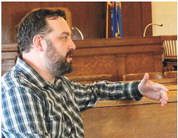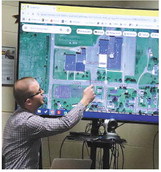Not enough teachers: Local schools struggle to fill staffs
Dominoes. Free agency. Whack-a-mole. Though not much in common on the surface, each of these words were recently used by local district administrators to describe the current teacher shortage that is affecting school districts across the area. While the situation itself has been going on for the past several years, this year the shortage has hit a new fevered pitch as schools struggle to fill all positions just weeks ahead of the upcoming school year.
Several factors have played into the current situation district administrators have been dealing with for the past several months. The biggest by far, however, is the ever shrinking pool of available teachers, which -- much like a desert oasis -- has become smaller as the amount of newly educated teachers out of college are not enough to replace the field of retiring teachers.
“I think the last two to two and a half years have been difficult for schools in general,” said Loyal district administrator Chris Lindner. “That has caused more retirements and people moving out of education ... now it’s just them (the teachers) moving around from one school to another. That’s the times we’re in. It’s not going to get better. The number of educators coming through college are very low. The need is out there, and the pool is only so big. And that pool is shrinking.”
Spencer district administrator Mike Endreas can definitely attest to the large amounts of teachers retiring. This past year, he said the school had nine teachers retire and he expects to have several more retire over the next couple of years. Starting in April, it was his job to find replacements for that large pool of retirees in addition to the 24 other open positions the Spencer School District had this year. The whole situation, he said, was unprecedented.
“It’s interesting,” he said. “I did some numbers and we have 25 teaching staff, an elementary principal, four paraprofessionals, two kitchen staff and a Rookie Rocket Learning Center Director that we have had to hire this year. That’s 33 people total, well over a third of our staff ... If I look back 10 years ago, the question I had was, have we had that many people in that timeframe before? We had multiple years worth of hiring done just for this year. In a normal year, we have two or three new staff. We had nine retirees and four new positions that we created for this year.”
As for where the rest of the missing staff went, all the local district administrators found they either returned home to their native district or just a short distance away to another local school.
“The trend that people say is happening is that people are leaving jobs for more money,” said Endreas. “That’s not what I’m seeing. I’m seeing people leaving jobs for more personal or professional reasons. Most have been taking jobs in their hometown. They want to go back home. We lost a few to them moving up and taking on more administrative positions.”
“They’re moving for good reasons,” added Greenwood district administrator Joe Green. “Family, a fresh start, looking for life changes or a different career path, and obviously for some, pay increases. The vast majority of staff that left us last year left because of location. They want to be closer to home. Some of them were fueled by the rising gas prices. With gas at $4-5 per gallon, it makes it hard to drive to work for 40 miles when there are other schools hiring closer to home.”
As these teachers shift around from school to school, it is becoming clearer just how many teaching staff are out there to fill positions. And that number is not enough to meet the demands of so many schools.
“We are experiencing a domino effect,” said Granton district administrator James Kuchta. “A teacher will be hired from school A and that school will hire someone from school B and that one from school C. They are moving from one school to another.”
“The problem is that it has become a whack-a-mole situation, like tossing around a hot potato,” added Endreas on the same subject. “Who will be left holding the open position? For example, you hire for a physical education teacher, you will go to another school to get that, then they will have an opening. Nine times out of 10 there will be a school down the end of the line that will not be able to fill that position and will be forced to look for a long term sub.”
This situation is one that is being played out at both the Granton and the Loyal school districts. In Granton, the district will be starting the year without a middle school and business education teacher while in Loyal, the school is still looking for a choir and general music teacher. In both cases, the gap in their staffing is not because they haven’t tried to find someone; there just isn’t anyone left to hire.
“We have had zero applicants,” said Kuchta. “We have had these listings since we knew we were going to need them back in May ... We’ve had it listed on the website WeCan, which is the state teacher hiring website, we have been in constant communication with WIP, the Wisconsin Internship Program, to fill positions. But we are running out of options this late in the game.”
“It’s been a challenge,” added Lindner on the struggle in Loyal. “It is similar to free agency out there. I’ve talked to a couple districts last week and some of them are still receiving resignations this late in the game. It makes it tough ... The question is what can we do to find applicants? We posted jobs on WeCan, the teacher job site, but we have also looked at other areas, word of mouth, talking to other superintendents. We haven’t gotten anything out of it.”
With no other options, both schools have had to look at alternatives to make sure their students can still be taught the classes they signed up for. In Granton, Kuchta said the school has found a way to split the duties of the needed middle school teacher position among the members of its high school and middle school staff while courses taught by the business education teacher will be taken online through Rural Virtual Academy (RVA).
“We are looking at a plan B for both (the middle school and business education positions),” said Kuchta. “We are going to have some high school teachers helping out with teaching science and math for middle school. Our staff have risen to the challenge and we are working with our staff to make this work. We have some retired teachers coming back to help us out ... We can offer students online classes through the RVA, which we had joined earlier this year. It’s not as good as in person, but we are looking at ways to still be able to offer students these courses.”
In Loyal, the situation is a bit trickier. Lindner said the district is continuing its search for a teacher to fill its needed music positions, even reaching out to the nearby school districts to see if teacher sharing would be a possibility. As of right now, the situation is unresolved, but the school is confident it will be able to find a way to continue to offer music to their students.
“For choir and general music we are still looking,” he said. “We originally had a couple applications, but one decided to get a job in their hometown and the other wanted to focus on a different area of music. We had interviewed those two way back in the spring and we haven’t had anyone apply since ... We have to ask ourselves how do we do something different? Music is important and we still need to offer it in some way.”
The ongoing teacher shortage has driven a lot of change in the way districts have had to hire and look for applicants. Endreas said in the past, applicants came to the districts -- often in droves -- to try to get a job. Now, the tables have turned and administrators have had to spend more time and resources in getting the few applicants out there to come to their school.
“There are not as many applicants,” he said. “Back in the day we used to have 80 to 100 applicants for a job. Now we get seven or eight. You have to be quick to get on it right away ... As soon as we had an opening we posted for it. Normally you would have it open for two weeks then start interviews, but we started interviewing as soon as we got an application. We are not waiting. The sooner you can get teachers signed, the better.”
Another avenue the districts have been looking into to get more teachers is through finding potential staff from within their nearby communities. For Granton and Loyal, that strategy was used to bring in a few former teachers and others with college degrees to their schools to fill positions. In Greenwood, Green said they were able to have a few of their support staff gain the certification and licensure they needed to become teachers for the year.
“We’re using a couple of long-term subs and we just filled some positions,” said Lindner. “For example, for our art class, the art teacher that is here this year, we reached out to her. She is retired and she is helping us out until we find somebody, that is the situation for us with our long-term subs.”
“We were fortunate to have a couple of our staff go through the non-traditional route,” said Green. “A couple of our support staff who had bachelor’s degrees went through the process to be licensed to teach for the upcoming year. We were very fortunate to have that.”
Keeping wages and benefits competitive has been another piece to this puzzle. Each district administrator said they have worked hard to make sure their wages are competitive with other school districts and have even altered some of their benefits to make sure any applicant will have security at their position. What can be more important than money, however, is the atmosphere of the school and surrounding community, and that is something that administrators have begun to focus more attention on.
“We’re doing everything we can to try to recruit,” said Kuchta. “We started with competitive wages and benefits, the (Granton School) Board looked at compensation and benefits and have made changes to make them more competitive.”
“One thing to keep in mind is that it’s not always just about the money,” said Green. “We need to build a culture of support in the school and community and show that it respects its educators. School districts are being forced to find ways to be more creative with staffing and flexible with staffing and accommodating with staffing.”
For now, it looks like a lot of the changes the schools have made so far to get the staff that they need will be here to stay. As they look to what the immediate future will bring for their districts, the administrators said the shortage of teachers isn’t going to be changing anytime soon. There will continue to be less and less staff available and schools will have to rely more on each other to make sure their kids still are able to receive the education they need to thrive. “I think districts our size will continue to be maintainable and competitive in relation to other schools,” said Endreas. “(Collaborating with nearby schools) that is nothing new. We go back and through the years we have shared physical education teachers, business teachers and calculus teachers. A lot of that is through the CWETN Network that area schools participate in ... The issue is that you are going to end up seeing more and more core classes, like English, that will need a teacher.”
“What this has started is more cooperation with neighboring districts” added Lindner on the same subject. “How can we work with them and collaborate resources? Whatever happens, this is setting up for our future. It’s not just one of us, this is all over.”
The only sure-fire way to get out of the current situation, the administrators all agreed, is to show current high school students that there is a future in becoming an educator.
“There are not many people going into education,” said Kuchta. “We need to be able to encourage that. We’re very much like the rest of the workforce right now. We need more people to go into these fields.”
“I think that it’s going to get worse until we are able to do something as a system to encourage more high school kids to go into teaching,” added Green. “I don’t believe there is a more noble career than teaching. I don’t think there is a more important occupation. The work they do is important.”
“I think that it’s going to get worse until we are able to do something as a system to encourage more high school kids to go into teaching. I don’t believe there is a more noble career than teaching. I don’t think there is a more important occupation. The work they do is important.” -- Greenwood District Administrator Joe Green






